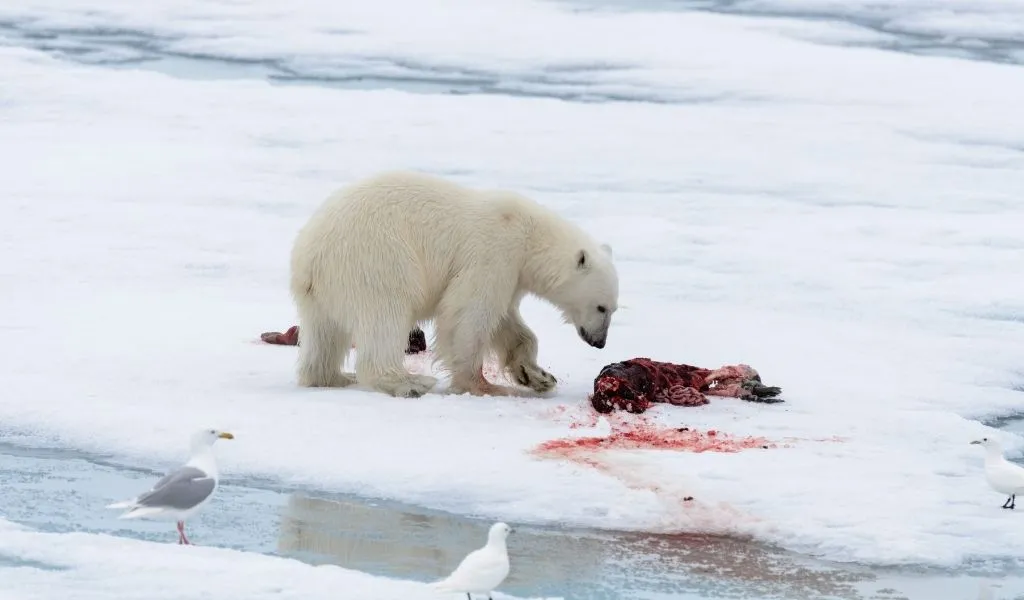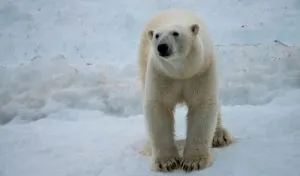Most bear species are omnivores, living off a diet of both animals and plants. But, what about those that live in the arctic tundra where plants are few and far between, are polar bears omnivores or carnivores?
Polar bears are widely considered to be carnivores as their diet mainly consists of ringed and bearded seals. However, during summer months when they cannot hunt seals, polar bears have been known to eat algae, berries, and eggs alongside their normal meat-based diet, so some experts call them hypercarnivores.
Keep reading to find out more about the diet of polar bears, how this changes throughout the year, and how climate change is impacting their food supply.
Is a Polar Bear Carnivore, Herbivore or Omnivore?
Although most bears can be considered omnivores as they eat both plants and meat, polar bears are carnivores because their diet mainly consists of meat.
This is reflected in their teeth where they have huge canines which are typical of a carnivore and smaller molars when compared to other omnivorous bears1 (source: Polar Bear, M. Fee, 2019).
The diet of a polar bear is mostly ringed seal and their pups, as well as occasional bearded seal. During winter when there is lots of sea ice in the arctic, they use this as a platform to catch seals from the ocean.
However, during the summer months when the sea ice melts, polar bears are unable to hunt for seals. Luckily, they are able to build up excess fat reserves during the winter to help get them through the summer.
Although some polar bears build up enough fat reserves to last through summer, studies have shown that most polar bears require extra food sources to offset energy loss2 (source: Journal of Mammalogy, M.G. Dyck and E. Kebreab, Vol 90, Issue 3, 2009). They continue to hunt for animals such as caribou, muskox, and birds which are more widely available.
However, they have also been known to eat marine algae, grass, berries, and eggs3 (source: Ecology Evolution, L. J. Gormezano and R. F. Rockwell, Vol 3, Issue 10, 2013), so some experts call them hypercarnivores. This is an animal whose diet is more than 70% meat.
What Do Polar Bears Eat?
Watch the video version here or keep reading below:
Studies of polar bears across the Arctic in North America and Eurasia have found that their diet is fairly consistent between populations. Here is a breakdown of what polar bears eat:
1. Seals
The vast majority of polar bears eat seals as their main food source. Ringed seals are the primary prey for polar bears across the Arctic, this is closely followed by bearded seals4 (source: Polar Biology, M. P. Galicia et al, Vol 38, Issue 12, 2015).
Polar bears will switch their main food source depending upon what is most widely available. For example, in the Hudson Bay area, they used to primarily feed on bearded seals but switched to ringed seals when these became more abundant5 (source: Ecology Evolution, L. J. Gormezano and R. F. Rockwell, Vol 3, Issue 10, 2013).
It has also been reported that polar bears eat other species of seal such as harp, hooded, and harbor seals, although these are less widely available so can only be found in certain populations6 (source: The diet of polar bears (Ursus maritimus) from Svalbard, Norway, inferred from scat analysis, M. Iversen, 2011).
2. Beluga Whale, Narwhale, and Walrus
Polar bears also feed on larger-bodied marine mammals such as beluga whales, narwhal, and walrus in areas where they are abundant.
After ringed and bearded seals, beluga whales are the third-largest contributor to the polar bear diet, eaten by around half of the population.
However, beluga whales are more commonly eaten by adult males than adult females, this is likely due to the size of beluga whales which can be as much as 1500KG compared to sales that weigh between 65-300kg7 (source: Polar Biology, M. Galicia, G.W. Thiemann and M. Dyck, Vol 38, Issue 12, 2015). Male polar bears are much larger than females so have to consume more energy to maintain their weight.
It is likely that these larger marine mammals would be shared between a group of polar bears rather than being eaten by a single bear as would be the case with seals8 (source: Ecological Monographs, G. W. Thiemann, S. J. Iverson and I. Sterling, Vol 78, Issue 4, 2008).
3. Terrestrial Mammals and Other Food Sources
During ice-free periods when polar bears are bound to land, they are very versatile and will hunt a variety of terrestrial mammals including caribou and snow geese9 (source: BMC Ecology, L. J. Gormezano and R. F. Rockwell, Vol 13, Issue 51, 2013).
They have also been known to take eggs and chicks from cliffs, marine birds, and have been spotted hunting fish.
Polar bears might be considered opportunistic hunters as they will eat a wide variety of food sources when supply is scarce. This includes plants such as Lyme grass seed heads, berries, and marine algae10 (source: BMC Ecology, L. J. Gormezano and R. F. Rockwell, Vol 13, Issue 51, 2013).
Polar bears minimize their metabolic rate during summer which puts them in a fasting-like state. The benefit of eating plants and berries is that it minimizes the energy they need to consume when foraging.
Mixing terrestrial mammals and plant-based carbohydrates is a similar strategy that other bear species use to maximize their weight gain.
How Much Do Polar Bears Eat?
The polar bear’s main food source, seal blubber, is very high in energy, so polar bears do not need to eat a large amount of food relative to their weight.
A typical 500kg polar bear would only need to eat 1 kg of seal blubber per day to maintain its body mass11 (source: Journal of Mammalogy, M.G. Dyck and E. Kebreab, Vol 90, Issue 3, 2009), although, they can eat much more than this in one sitting.
It was previously thought that polar bears fasted throughout the summer months, relying on their fatty reserves from the abundant winter.
However, more recent studies suggest that this is not the case as they need to top up their reserves with terrestrial animals and anything else they can find. This is likely a response to the melting sea ice which reduces their winter hunting season due to melting earlier than usual.
Polar bears need to consume high amounts of energy because they can burn through 12,325 calories per day. By early summer, they can reach a relative fatness of 1kg of fat per 1kg of lean body mass12 (source: Science, Pagano et al, vol 359, 2018).
How Do Polar Bears Get Their Food?
Polar bears catch most of their prey during winter. They will usually sit beside a hole in the ice, waiting for a seal to appear13 (source: Encyclopedia of Marine Mammals (2nd Ed), I Sterling, 2009). They have a long snout and neck which helps them to pull seals out through the hole.
Hunting strategies vary, they also use the ice as a launching point to dive in the water and catch marine mammals such as seals, beluga whales, and walrus. During the summer when they start to prey on terrestrial mammals and birds, they exhibit hunting tactics similar to other large carnivores14 (source: Science, Pagano et al., Vol 359, 2018).
There’s an old polar bear joke that goes “How do polar bears catch fish? With their bear hands”, but this isn’t too far from the truth. They have short, broad, and curved claws which are perfect for catching slippery prey such as seals15 (source: Polar Bear, M. Fee, 2019).
They have partial webbing between their toes which is why they are great swimmers. They also have hollow fur which provides some buoyancy.
How Climate Change is Affecting the Polar Bears Diet
Polar bears rely on the sea ice as a launching-off point to catch seals, walrus, and other water-based prey which forms a large part of their diet.
However, with sea ice in the Arctic melting at a rapid rate and scientists projecting ice-free summers in the Arctic before the end of the century, if not in the next few decades16 (source: The Guardian), it is becoming harder for them to catch such prey.
Luckily, polar bears are adaptive animals that will switch their diet to more abundant sources. Many polar bear populations have already started to eat terrestrial animals such as caribou and plants17 (source: Ecology Evolution, L. J. Gormezano and R. F. Rockwell, Vol 3, Issue 10, 2013).
One key factor that could determine the future of the polar bear is competition with their sister species, grizzly bears (brown bears). As they are forced to look for food further south, they will increasingly hunt for the same prey as grizzly bears.
Scientists are unsure how this will impact polar bears, but three scenarios seem likely:
- Adapt – They may change their diet to reduce competition with grizzly bears
- Hybridization – They may reproduce with grizzly bears to produce offspring well adapted to changing conditions
- Extinct – They may not be able to adapt and become extinct.
Source: Global Change Biology
Related Questions
Do Polar Bears Eat Seals?
Yes, polar bears eat seals as their main food source. Most polar bears eat ringed seals due to being the most abundant, however, they will also eat bearded seals, harp seals, hooded seals, and harbor seals in regions where these can be found.
Do Polar Bears Eat Penguins?
No, polar bears do not eat penguins. Although penguins would happily fit the diet of polar bears, they live at opposite ends of the world.
Polar bears live in the Arctic around the north pole whereas penguins live in the southern hemisphere such as Antarctica, Australia, Africa, and South America.
Do Polar Bears Eat Walrus?
Yes, although polar bears primarily feed on seals, they are also well known for eating Atlantic walrus in areas where they are abundant such as foxe basin, north of Canada. In these areas, adult male polar bears are the primary predator of walrus18 (source: Canadian Journal of Zoology, G.W. Thiemann et al, Vol 85, No. 4, 2007).
Do Polar Bears Eat Humans?
No, polar bears do not usually eat humans and will often avoid conflict with them. During 1870-2014, there were just 73 recorded attacks by polar bears on humans across their entire range which makes these attacks very rare. A total of 20 people were killed during this period19 (source: Wildlife Society Bulletin, J. M. Wilder et al, Vol 41, Issue 3, 2017).
Attacks are usually by malnourished males or involve food/waste at campsites. These attacks may become more prevalent as climate change results in sea ice melting earlier. This means polar bears will not have adequate time to top up their fat reserves for the summer so may become malnourished more frequently.
Do Polar Bears Eat Arctic Foxes?
No, polar bears don’t usually eat arctic foxes. the two have an interesting relationship. When food is abundant, arctic foxes can be seen following polar bears on the sea ice and scavenging on the seal carcasses they leave behind.
However, when food is scarce, polar bears may consider the arctic fox as prey and wouldn’t hesitate to eat it.
Which Animals Eat Polar Bears?
Polar bears are at the top of the arctic food chain so they have no natural predators. However, polar bear cubs may be eaten by wolves and other carnivores in the region20 (source: Seaworld).
Do Polar Bears Eat Their Young?
There have been some reports that polar bears eat their young during times when food is scarce.
Whilst there is some evidence pointing to cannibalism among polar bears, there is a lot of dispute among the scientific community over the prevalence of this and whether it is increasing or not21 (source: Polar Bear Science).
As it stands, there is no compelling evidence to suggest that this is common or that it is increasing.
Do Polar Bears Eat Dolphins?
No, polar bears don’t normally eat dolphins because they usually migrate south for Winter and avoid the bears, however, you may occasionally spot a polar bear feasting on dolphins that become stuck in the Arctic as it freezes over. This could increase in future as the Arctic waters warm and dolphins venture further north22 (source: New Scientist).




![Read more about the article 42 Polar Bear Jokes [Sure to Break the Ice]](https://polarguidebook.com/wp-content/uploads/2021/09/Polar-bear-jokes-300x176.jpg)
![Read more about the article What Color is a Polar Bear? [The Answer is Not What You Think]](https://polarguidebook.com/wp-content/uploads/2021/09/What-color-are-polar-bears-300x176.jpg)